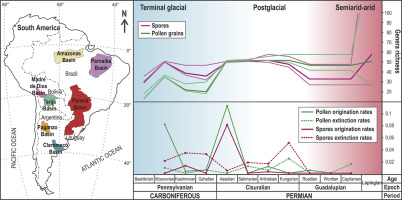当前位置:
X-MOL 学术
›
J. South Am. Earth Sci.
›
论文详情
Our official English website, www.x-mol.net, welcomes your feedback! (Note: you will need to create a separate account there.)
Sampling biases and Paleozoic sporomorphs diversity dynamics in Western Gondwana strata
Journal of South American Earth Sciences ( IF 1.8 ) Pub Date : 2020-03-01 , DOI: 10.1016/j.jsames.2019.102457 Ángeles Beri , Ximena Martínez-Blanco , Luciano Varela , Mercedes di Pasquo , Paulo Alves de Souza
Journal of South American Earth Sciences ( IF 1.8 ) Pub Date : 2020-03-01 , DOI: 10.1016/j.jsames.2019.102457 Ángeles Beri , Ximena Martínez-Blanco , Luciano Varela , Mercedes di Pasquo , Paulo Alves de Souza

|
Abstract A dataset consisting of presence-absence data of 137 pollen and spore genera was elaborated with published sources from Pennsylvanian and Permian Atlantic (Parana, Parnaiba, Amazonas, and Claromeco) and Pacific (Paganzo, Tarija, and Madre de Dios) basins of South America. The richness and origination, extinction, and sampling rates of sporomorphs were analyzed in order to address the effect of sampling biases over diversity estimations. Richness and sampling were estimated using the recently developed True Richness estimated using a Poisson Sampling (TRiPS) model. Origination, extinction, and sampling rates were estimated with Inverse Survivorship Models. The TRiPS analysis showed changes in richness during the studied interval. The highest richness was observed for the Cisuralian, and the lowest richness was recovered for the Pennsylvanian and Guadalupian. The best supported Inverse Survivorship Model revealed that the highest origination values occurred between the Gzhelian and Asselian, whereas the highest observed extinction rate occurred between the Kungurian and the Roadian. In particular, pollen grains showed higher net diversification than spores, while spores showed higher turnover than pollen grains. Also, an alternation in richness dominance was observed at the beginning of the Permian, with pollen grains showing higher richness after the Artinskian. Changes in total sporomorphs diversity, as well as differences between spores and pollen grains, may be related to changing climatic conditions in Western Gondwana during the late Paleozoic (from icehouse to greenhouse conditions) that could impact differently over plant communities. Although the fossil palynomorph record has been widely used as a biostratigraphic tool, our results highlight its importance and usefulness for the study of plant communities and their evolution in the past.
中文翻译:

冈瓦纳西部地层采样偏差和古生代孢子形多样性动态
摘要 利用宾夕法尼亚和二叠纪大西洋(巴拉那、帕奈巴、亚马逊和克拉罗梅科)和太平洋(帕甘佐、塔里哈和马德雷德迪奥斯)盆地的公开资料,详细阐述了一个由 137 个花粉和孢子属的存在-不存在数据组成的数据集。美国。分析了孢子体的丰富度和起源、灭绝和采样率,以解决采样偏差对多样性估计的影响。使用最近开发的使用泊松采样 (TRiPS) 模型估计的真实丰富度来估计丰富度和采样。起源、灭绝和采样率是用逆生存模型估计的。TRiPS 分析显示了研究间隔期间丰富度的变化。Cisuralian 的丰度最高,宾夕法尼亚人和瓜达卢皮人的丰度最低。最佳支持的逆生存模型显示,最高的起源值发生在 Gzhelian 和 Asselian 之间,而观察到的最高灭绝率发生在 Kungurian 和 Roadian 之间。特别是,花粉粒比孢子表现出更高的净多样化,而孢子比花粉粒表现出更高的周转率。此外,在二叠纪初期观察到丰富度优势的交替,在阿廷斯基期之后花粉粒显示出更高的丰富度。总孢子形多样性的变化,以及孢子和花粉粒之间的差异,可能与晚古生代(从冰库到温室条件)西部冈瓦纳的气候条件变化有关,这可能对植物群落产生不同的影响。尽管化石孢粉记录已被广泛用作生物地层学工具,但我们的研究结果强调了其在过去研究植物群落及其演化的重要性和有用性。
更新日期:2020-03-01
中文翻译:

冈瓦纳西部地层采样偏差和古生代孢子形多样性动态
摘要 利用宾夕法尼亚和二叠纪大西洋(巴拉那、帕奈巴、亚马逊和克拉罗梅科)和太平洋(帕甘佐、塔里哈和马德雷德迪奥斯)盆地的公开资料,详细阐述了一个由 137 个花粉和孢子属的存在-不存在数据组成的数据集。美国。分析了孢子体的丰富度和起源、灭绝和采样率,以解决采样偏差对多样性估计的影响。使用最近开发的使用泊松采样 (TRiPS) 模型估计的真实丰富度来估计丰富度和采样。起源、灭绝和采样率是用逆生存模型估计的。TRiPS 分析显示了研究间隔期间丰富度的变化。Cisuralian 的丰度最高,宾夕法尼亚人和瓜达卢皮人的丰度最低。最佳支持的逆生存模型显示,最高的起源值发生在 Gzhelian 和 Asselian 之间,而观察到的最高灭绝率发生在 Kungurian 和 Roadian 之间。特别是,花粉粒比孢子表现出更高的净多样化,而孢子比花粉粒表现出更高的周转率。此外,在二叠纪初期观察到丰富度优势的交替,在阿廷斯基期之后花粉粒显示出更高的丰富度。总孢子形多样性的变化,以及孢子和花粉粒之间的差异,可能与晚古生代(从冰库到温室条件)西部冈瓦纳的气候条件变化有关,这可能对植物群落产生不同的影响。尽管化石孢粉记录已被广泛用作生物地层学工具,但我们的研究结果强调了其在过去研究植物群落及其演化的重要性和有用性。



























 京公网安备 11010802027423号
京公网安备 11010802027423号